oil AUDI Q3 2017 Owner´s Manual
[x] Cancel search | Manufacturer: AUDI, Model Year: 2017, Model line: Q3, Model: AUDI Q3 2017Pages: 236, PDF Size: 58.93 MB
Page 5 of 236
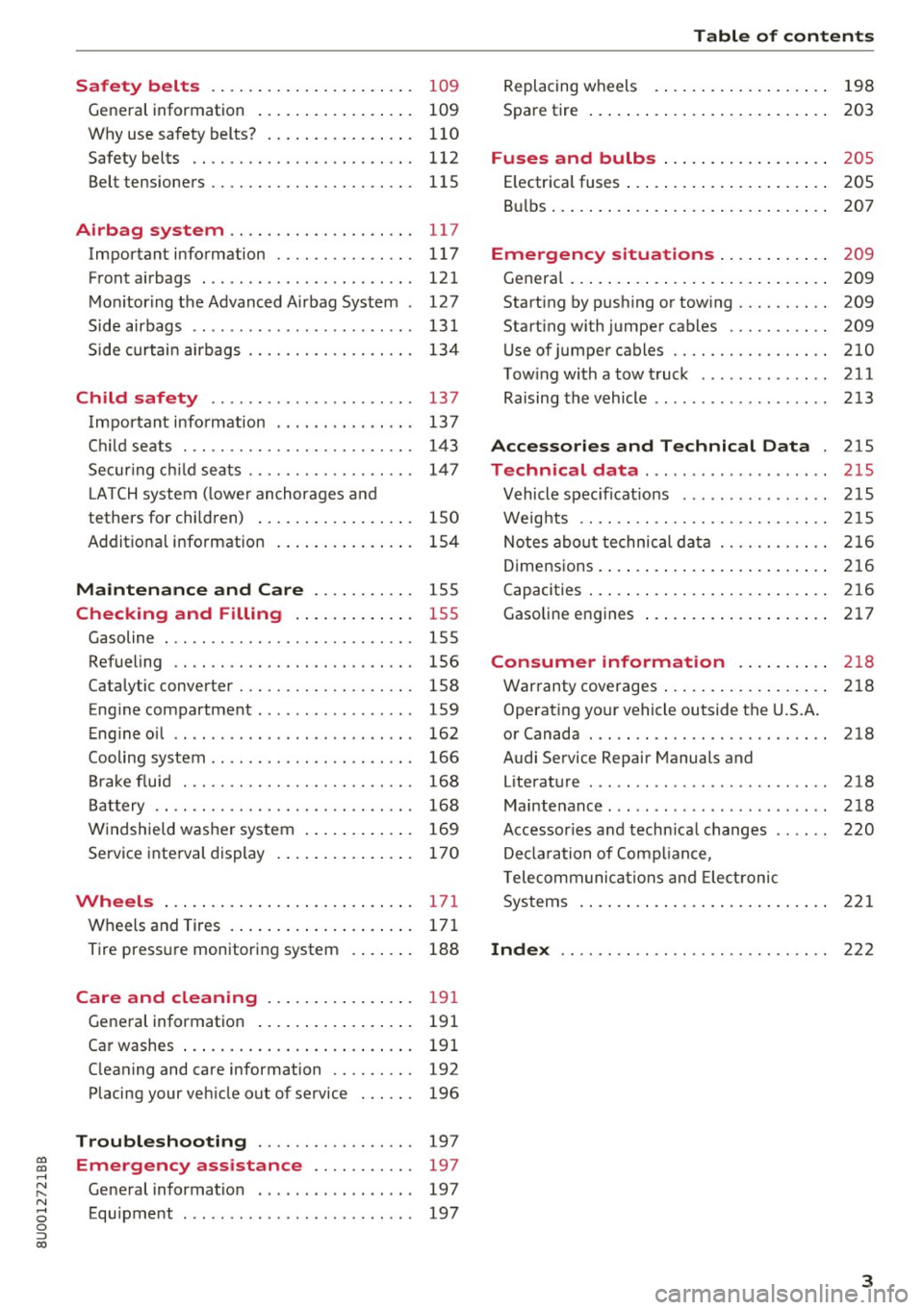
00
00
......
"' ,-...
"' ...... 0 0 :::,
00
S afe ty belt s . . . . . . . . . . . . . . . . . . . . . . 109
General information . . . . . . . . . . . . . . . . . 109
Why use safety belts? . . . . . . . . . . . . . . . . 110
Safety belts ........................ 112
Belt tensioners . . . . . . . . . . . . . . . . . . . . . . 115
Airb ag sy stem . . . . . . . . . . . . . . . . . . . . 11 7
Important information . . . . . . . . . . . . . . . 117
Front a irbags . . . . . . . . . . . . . . . . . . . . . . . 121
M on itor ing the Advanced Airbag System . 127
Side airbags . . . . . . . . . . . . . . . . . . . . . . . . 131
S ide curtai n airbags . . . . . . . . . . . . . . . . . . 134
Ch ild safety . . . . . . . . . . . . . . . . . . . . . . 137
I mpor tant info rmation . . . . . . . . . . . . . . . 137
C hi ld se ats . . . . . . . . . . . . . . . . . . . . . . . . . 14 3
Secur ing c hild seats . . . . . . . . . . . . . . . . . . 14 7
L ATCH system ( lowe r anchorages and
tethers for chi ldren) . . . . . . . . . . . . . . . . . 150
Additional information . . . . . . . . . . . . . . . 154
Maintenance and Care . . . . . . . . . . . 155
Checking and Filling . . . . . . . . . . . . . 155
Gasoline . . . . . . . . . . . . . . . . . . . . . . . . . . . 155
Refueling . . . . . . . . . . . . . . . . . . . . . . . . . . 156
Cata lytic converter . . . . . . . . . . . . . . . . . . . 158
Eng ine compartment . . . . . . . . . . . . . . . . . 159
E ng ine oil . . . . . . . . . . . . . . . . . . . . . . . . . . 162
Cooling system . . . . . . . . . . . . . . . . . . . . . . 166
B ra ke flu id . . . . . . . . . . . . . . . . . . . . . . . . . 168
B at tery . . . . . . . . . . . . . . . . . . . . . . . . . . . . 168
W indshield was her system . . . . . . . . . . . . 169
Service inte rval display . . . . . . . . . . . . . . . 170
Wheel s ... .. .. ... ..... ... .. .. .... . 171
Wheels and Tires . .. ..... ... .. .. .... . 171
Tire press ure monitoring system 188
Care and cle aning . . . . . . . . . . . . . . . . 191
General information . . . . . . . . . . . . . . . . . 19 1
Ca r washes ... .. ... . .... ... .. .. .. .. . 191
C leaning and care information . . . . . . . . . 192
Placing your veh icle out of service . . . . . . 196
Troubleshooting . . . . . . . . . . . . . . . . . 197
Emergency assistance . . . . . . . . . . . 197
General information . . . . . . . . . . . . . . . . . 197
Equipment . . . . . . . . . . . . . . . . . . . . . . . . . 197
Table of contents
Replacing wheels . . . . . . . . . . . . . . . . . . . 198
Spare tire . . . . . . . . . . . . . . . . . . . . . . . . . . 203
Fuses and bulbs . . . . . . . . . . . . . . . . . . 205
E lectrica l fuses . . . . . . . . . . . . . . . . . . . . . . 205
B ul bs . . . . . . . . . . . . . . . . . . . . . . . . . . . . . . 207
Eme rgency s ituation s . . . . . . . . . . . . 209
Genera l . . . . . . . . . . . . . . . . . . . . . . . . . . . . 209
Start ing by p ush ing or tow ing . . . . . . . . . . 209
Start ing with jumper cables . . . . . . . . . . . 209
U se of jumper cables .. .. .. .. .. .. .. .. . 210
Tow ingwithatowt ruck . .......... ... 211
Raising the vehicle . . . . . . . . . . . . . . . . . . . 213
Accessories and Technical Data . 215
Technic al d ata . . . . . . . . . . . . . . . . . . . . 215
Vehicle spec ificat ions . . . . . . . . . . . . . . . . 215
Weig hts . . . . . . . . . . . . . . . . . . . . . . . . . . . 215
Notes abo ut te chnical da ta . . . . . . . . . . . . 216
D imens ions. ... .. .. .... .. .... ... .. .. 2 16
Capacities . . . . . . . . . . . . . . . . . . . . . . . . . . 216
Gasoli ne engines . . . . . . . . . . . . . . . . . . . . 217
Consumer informat ion . . . . . . . . . . 218
War ranty coverages . . . . . . . . . . . . . . . . . . 218
Operating you r vehicle outside the U.S.A.
or Canada . . . . . . . . . . . . . . . . . . . . . . . . . . 218
Audi Service Repair Manuals and
Literat ure . . . . . . . . . . . . . . . . . . . . . . . . . . 218
Maintenance ...... .... ........... ... 218
Accessor ies and techn ica l changes . . . . . . 220
De claration of Comp liance,
T elecomm unica tions and Ele ctr onic
Systems . . . . . . . . . . . . . . . . . . . . . . . . . . . 221
Index ............................. 222
3
Page 11 of 236
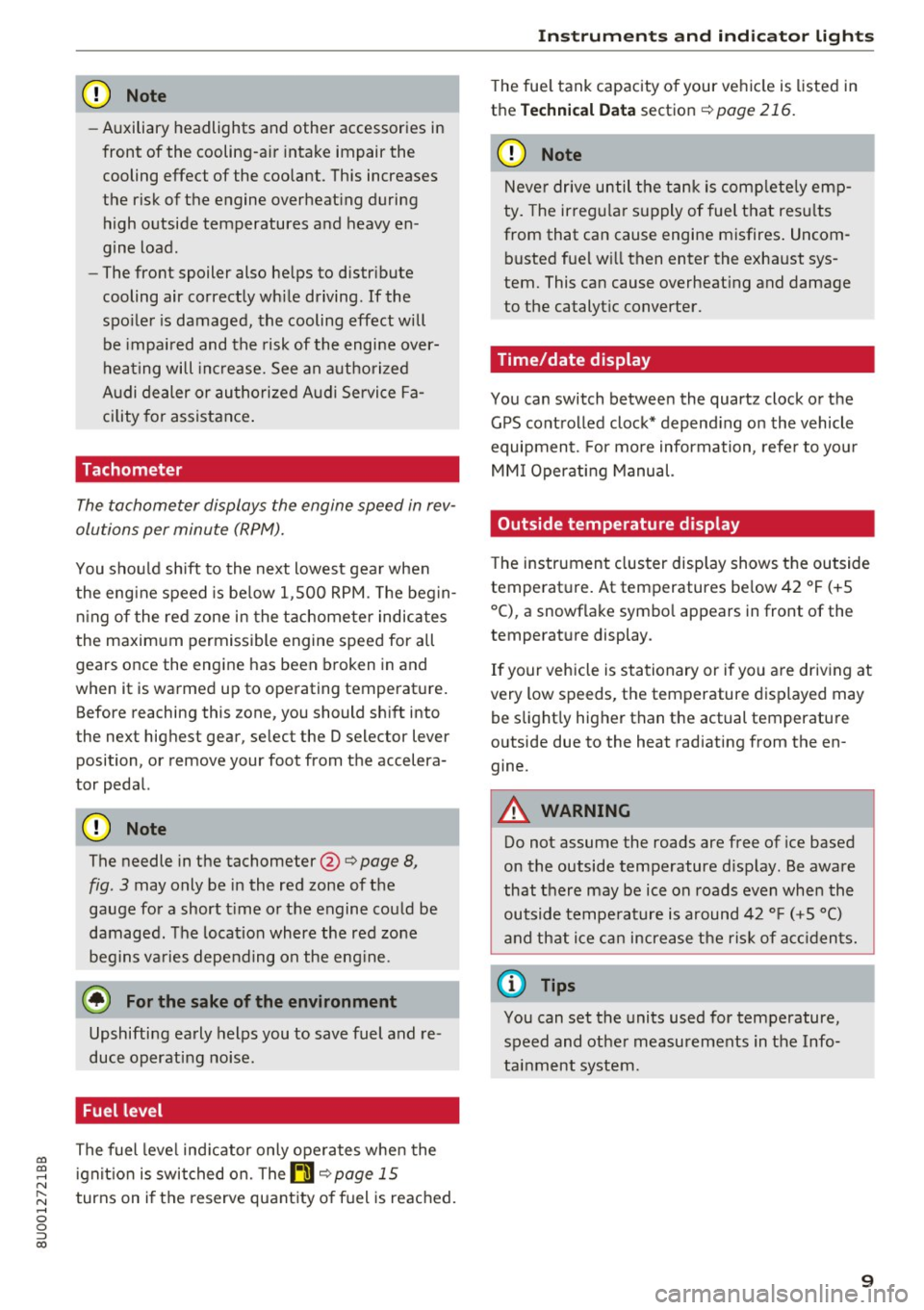
00
00
......
"' ,....
"' ...... 0 0 :::,
00
CD Note
- Auxiliary headlights and other accessories in
front of the cooling-air intake impair the
cooling effect of the coolant. This increases
the risk of the engine overheating during
high outside temperatures and heavy en-
gine load.
- The front spoiler also helps to distribute
cooling air correctly wh ile driving. If the
spo iler is damaged, the cooling effect will
be impai red and the risk of the engine over
heating will increase. See an authorized
A udi dealer or authori zed Aud i Service Fa
cility for assistance .
Tachometer
The tachometer displays the engine speed in rev
olutions per minute
(RPM).
You shou ld shift to the next lowest gear when
the eng ine speed is be low 1,500 RPM. The beg in
ning of the red zone in the tachometer indicates
the maximum permissible engine speed for all
gears once the engine has been broken in and
when it is warmed up to operating temperature.
Before reaching this zone, you should sh ift into
the next highest gear, select the D selector lever position, or remove your foot from the accelera
tor pedal.
CD Note
The needle in the tachometer @
Q page 8,
fig. 3 may only be in the red zone of the
gauge for a short t ime or the engine could be
damaged. The location where the red zone
begins va ries depend ing on the eng ine.
@) For the sake of the environment
Upshifting early helps you to save fuel and re
duce operating noise.
Fuel level
The fuel leve l ind icator only ope rates when the
i gnit io n is switched on. The
tD Qpage 15
turns on if the reserve quant ity of fuel is reac hed.
In strum ents an d ind ic a to r ligh ts
The fue l tank capacity of your vehicle is listed in
the Techni cal Data section
Q page 216.
(D Note
Neve r dr ive until the tank is comp lete ly emp
ty. The irregu la r supply of fuel that res ults
from that can cause engine misfires . Uncom
busted fuel w ill then enter the exhaust sys
tem. This can cause overheat ing and damage
to the catalyt ic converter.
Time/date display
You can switch between the quartz clock or the GPS controlled clock* depend ing on the vehicle
equipment. For mo re information, refe r to you r
MM I Operating Manual.
Outside temperature display
T he instrument cluster display shows the outside
temperature. At temperatures be low 42 °F ( +S
°C), a snowflake symbo l appears in front of the
temperature display.
If your vehicle is stationary or if you a re driving at
very low speeds, the temperature displayed may be slight ly higher than the actual temperature
o utside due to the heat radiating from the en
gine.
A WARNING
.-
Do not assume the roads are free of ice based
on the outside temperature d isplay. Be aware
that there may be ice on roads even when the
outside tempe rature is a round 42 °F (+5 °C)
a nd that i ce can increase t he risk of a cc idents.
(0 Tips
You can set the units used for temperature,
speed and othe r measurements in the Info
tai nment system.
9
Page 12 of 236
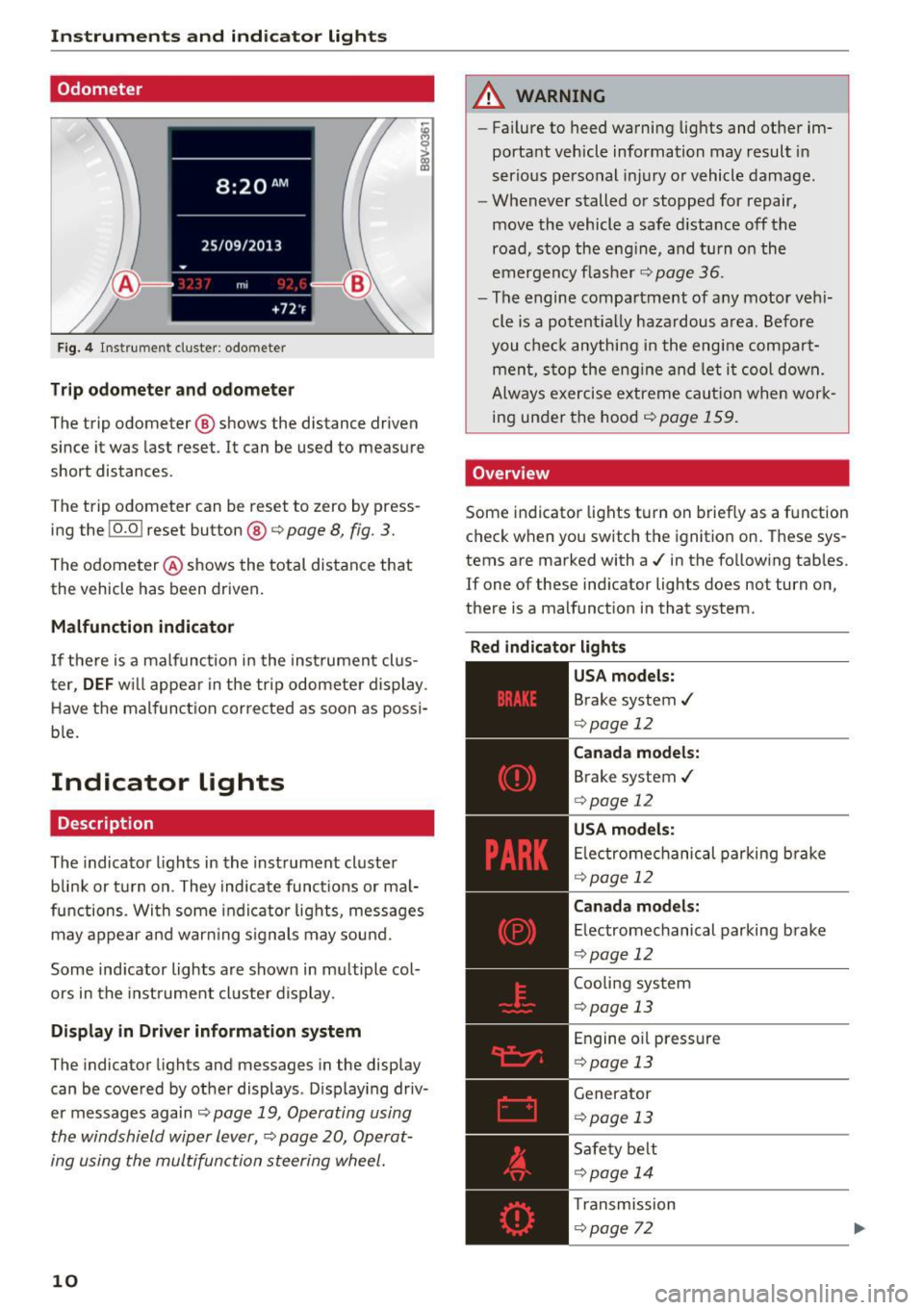
Instrumen ts and ind icator ligh ts
Odometer
Fig. 4 Instrument cluster: odometer
Trip odomete r and odomete r
The trip odometer @ shows the distance driven
since it was last reset. It can be used to measure
short distances .
The trip odometer can be reset to zero by press
ing the
j o.o l reset button @ c> page 8, fig. 3.
The odometer ® shows the total distance that
the vehicle has been driven.
Malfunction indicator
I f there is a malfunction in the inst rument cl us
ter,
DEF w ill appear in the trip odomete r display .
Have the malfunct ion corrected as soon as possi
ble.
Indicator lights
Description
The indicator lights in the instrument cluster
blin k or t urn on. They indicate funct ions or ma l
functions . Wi th some indicator lights, messages
may appear and war ning s ignals may sound.
Some indicator lights are shown in multiple col
ors in the inst rument cl uste r display.
Display in Driver information sy stem
The indicator lights and messages in the display
can be covered by other displays . D isplay ing driv
er messages again
c> page 19, Operating using
the windshield wiper lever,
c> page 20, Operat
ing using the multifunction steering wheel.
10
A WARNING
- Fai lure to heed wa rning lights and other im
porta nt vehicle information may result in
serious personal inj ury o r vehicle damage.
- Whenever stalled or stopped for repair,
move the vehicle a safe d istance off the
road, s top the eng ine , and turn on the
emergency f lasher
c> page 36.
-The engine compartment of a ny motor veh i
cle is a potent ia lly ha za rdous area. Before
you c hec k anything in the engine compa rt
men t, stop the eng ine and let i t cool down.
Always e xercise extreme cau tion when wor k
ing under the hood
c> page 159.
Overview
Some indicator lights t urn on brief ly as a function
check when you switch the ignition on. These sys
tems are marked with a./ in the follow ing tab les.
If one of these ind icator lights does not turn on,
there is a malfunct io n in that system.
Red indicator light s
--------------
US A models:
Brake system ./
c>page 12
Canada model s:
Brake system ./
c>page 12
USA model s:
El ec tromechanical parking brake
c> page 12
Canada model s:
E lectromechanical parking b rake
c> page 12
Cooling system
c>page 13
Engine oil pressure
c>page 13
Generator
c>page 13
Safety be lt
c>page 14
Transmission
c>page 72
Page 15 of 236
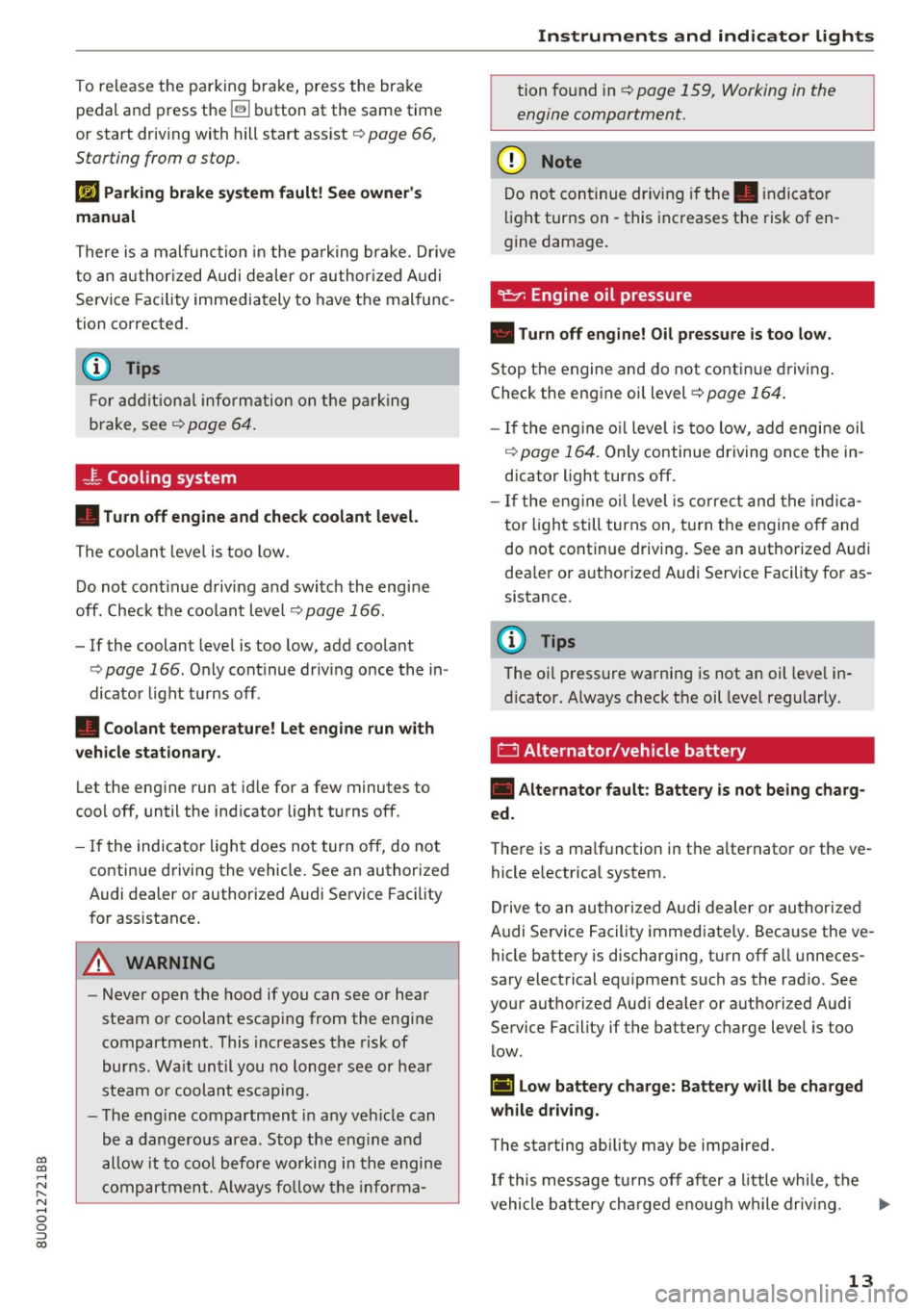
00
00
.....,
"' ,....
"' .....,
0 0 :::,
00
To release the parking brake, press the brake
pedal and press the~ button at the same time
or start driving with hill start assist
¢ page 66,
S tar ting from a s top.
rlJ Parking brake system fault! See owner's
manual
There is a malfunction in the parking brake. Drive
to an authorized Audi dealer or authorized Audi
Service Facility immediately to have the malfunc
tion corrected.
@ Tips
For additional information on the parking
brake, see
¢ page 64.
- ~- Cooling system
• Turn off engine and check coolant level.
The coolant level is too low.
Do not continue driving and switch the engine
off. Check the coolant level¢
page 166.
-If the coolan t level is too low, add coolant
¢page 166. Only continue driving once the in
dicator light turns off.
• Coolant temperature! Let engine run with
vehicle stationary.
Let the engine run at idle for a few minutes to
cool off, until the indicator light turns off.
- If the indicator light does not turn off, do not
continue driving the vehicle. See an authorized
Audi dealer or authorized Audi Service Facility
for assistance.
.&_ WARNING
- Never open the hood if you can see or hear
steam or coolant escaping from the engine compartment . This increases the risk of
burns. Wait until you no longer see or hear
steam or coolant escaping .
- The engine compartment in any vehicle can
be a dangerous area. Stop the engine and
allow it to cool before working in the engine
compartment. Always follow the informa-
-
Instruments and indicator lights
tion found in ¢ page 159, Working in the
engine compartment.
@ Note
Do not continue driving if the . indicator
light turns on -this increases the risk of en
gine damage.
Stop the engine and do not continue driving.
Check the engine oil level
¢ page 164.
- If the engine oil level is too low, add engine oil
c:!;> page 164. Only continue driving once the in
dicator light turns off.
- If the engine oil level is correct and the indica
tor light still turns on, turn the engine off and
do not continue driving. See an authorized Audi
dealer or authorized Audi Service Facility for as
sistance.
(D Tips
The oil pressure warning is not an oil level in
dicator. Always check the oil level regularly .
0 Alternator/vehicle battery
• Alternator fault: Battery is not being charg
ed.
There is a malfunction in the alternator or the ve
hicle electrical system .
Drive to an authorized Audi dealer or authorized
Audi Service Facility immediately. Because the ve
hicle battery is discharging, turn off all unneces
sary electrical equipment such as the radio. See
your authori zed Audi dealer or authori zed Audi
Service Facility if the battery charge level is too
low .
r•j low battery charge: Battery will be charged
while driving.
The starting ability may be impaired.
If this message turns off after a little while, the
vehicle battery charged enough while driving. ..,_
13
Page 17 of 236

00
00
......
"' ,....
"' ...... 0 0 :::,
00
A WARNING , ~ -
Have the malfunction in the safety systems
inspected immediately. Otherwise, there is a
r isk that the systems may not activate during
a collision, which increases the risk of serious
injury or death.
(0) Brake pads
Ei] Brake pad s!
The brake pads are worn .
Drive to an authorized Aud i dea ler or authorized
Audi Service Facility immediately to have the brake pads checked.
App lies to: USA models
The Ei] indicator light turns on together with the
1111 indicator light
EPC Engine control (gasoline engine)
Applies to: vehicl es with gasoline engines
If the 13:a indicator light turns on while driving,
there is an eng ine control malfunction.
Immediately drive slowly to an authorized Audi
dealer or authori zed Audi Service Facility to have
the malfunction corrected.
0 Malfunction indicator lamp (MIL)
The malfunction indicator lamp (MIL) is part of
the On Board Diagnostic system (OBD II). The
¢4 symbol turns on when the ign ition is switched
on and turns off again once the e ngine is started
and running at a steady id le speed . This indicates
that the MIL is functioning correctly.
The indicato r light turns on if there is a malfunc
tion in the engine electronics. See an autho rized
Audi dealer or authorized Audi Service Facility to
have the ma lfunction corrected. For additiona l
information, see
~ page 17.
The indicator light can also turn on if the f uel fill
e r cap is not closed correct ly
i::!> page 157.
Instruments and indicator lights
!"-" , Engine speed lim itation
Applies to: vehicles with engine speed limitation
(I! Maximum engine speed XXXX RPM
The engine speed is automatically limited to the
speed displayed in the driver information system.
This protects the engine from overheat ing .
The engine speed limitation deactivates once the engine is no longer in the critical temperature
range and you have released the accelerator ped
al once .
If the engine speed limitation was activated by
an engine control malfunction, the
13:a in dicator
light also turns on. Make sure that the speed
does not go above the speed displayed . Dr ive to
an authorized Aud i dea le r or authorized Audi
Service Facility immed iately to have the malfunc
tion corrected.
~;. Engine oil
Ill Check oil level.
Refill engine oil as soon as possible i::!>page 162.
~ .,. Engine oil sensor
• Oil level sensor: System fault!
The sensor to check the eng ine o il level has
failed. Drive to an authorized Audi dealer or au
thorized Aud i Serv ice Facility immediately to have
the malfunction cor rected.
i) Tank system
H Please refuel
If the indicator l ight turns on for the first time
and the message appears, there are about
1.8 -2.2 gallons ( 7.0 -8. S liters) of fuel left in the
tank .
H Fuel tank system malfunction! Contact deal
er
Drive to an authorized Audi dealer or authorized
Audi Service Facility immed iately to have the
malfunction corrected. ..,.
15
Page 60 of 236
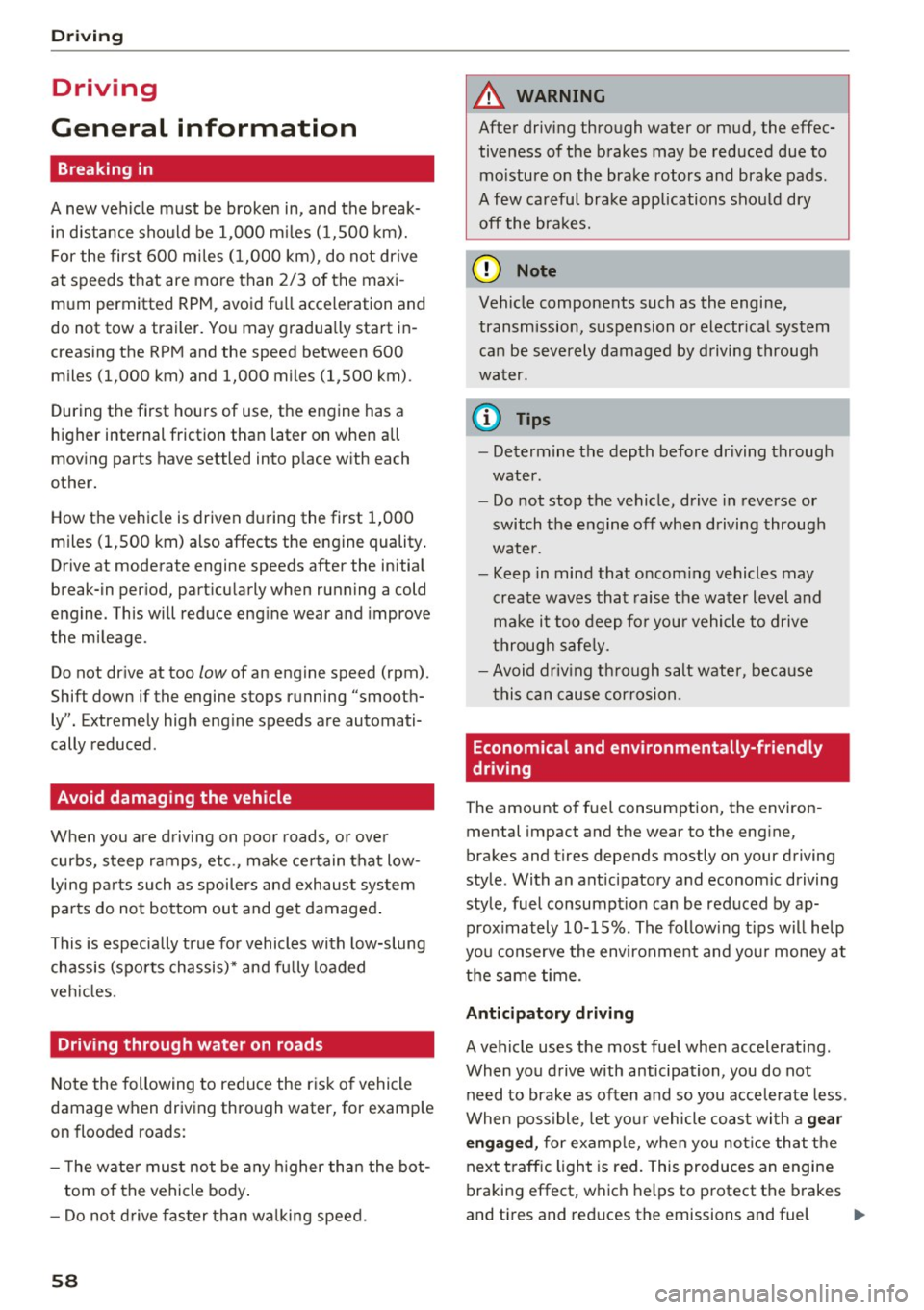
Driving
Driving
General information
Breaking in
A new vehicle must be broken in, and the break in distance should be 1,000 miles (1,500 km).
For the first 600 miles (1,000 km), do not drive
at speeds that are more than 2/3 of the maxi
mum permitted RPM, avoid full acceleration and
do not tow a trailer. You may gradually start in
creasing the RPM and the speed between 600 miles (1,000 km) and 1,000 miles (1,500 km) .
During the first hours of use, the engine has a
higher internal friction than later on when all
moving parts have settled into place with each
other.
How the vehicle is driven during the first 1,000
miles (1,500 km) also affects the engine quality.
Drive at moderate engine speeds after the initial
break-in period, particularly when running a cold
engine . This will reduce engine wear and improve
the mileage .
Do not drive at too
low of an engine speed (rpm).
Shift down if the engine stops running "smooth ly". Extremely high engine speeds are automati
cally reduced .
Avoid damaging the vehicle
When you are driving on poor roads, or over
curbs, steep ramps , etc., make certain that low
lying parts such as spoilers and exhaust system
parts do not bottom out and get damaged.
This is especially true for vehicles with low-slung
chassis (sports chassis)* and fully loaded
vehicles.
Driving through water on roads
Note the following to reduce the risk of vehicle
damage when driving through water, for example
on flooded roads:
- The water must not be any higher than the bot
tom of the vehicle body.
- Do not drive faster than walking speed.
58
A WARNING ,_
After driving through water or mud, the effec
tiveness of the brakes may be reduced due to
moisture on the brake rotors and brake pads.
A few careful brake applications should dry
off the brakes.
([) Note
Vehicle components such as the engine,
transmission, suspension or electrical system
can be severely damaged by driving through
water.
(D Tips
- Determine the depth before driving through
water.
- Do not stop the vehicle, drive in reverse or
switch the engine off when driving through
water.
- Keep in mind that oncoming vehicles may
create waves that raise the water level and
make it too deep for your vehicle to drive
through safely.
-Avoid driving through salt water, because
this can cause corrosion.
Economical and environmentally-friendly
driving
The amount of fuel consumption, the environ
mental impact and the wear to the engine,
brakes and tires depends mostly on your driving
style . With an anticipatory and economic driving
style, fuel consumption can be reduced by ap proximately 10-15%. The following tips will help
you conserve the environment and your money at
the same time.
Anticipatory driving
A vehicle uses the most fuel when accelerating .
When you drive with anticipation, you do not need to brake as often and so you accelerate less.
When possible , let your vehicle coast with a gear
engaged, for example, when you notice that the
next traffic light is red. This produces an engine
braking effect, which helps to protect the brakes
and tires and reduces the emissions and fuel
...
Page 61 of 236

00
00
......
"' ,....
"' ...... 0 0 :::,
00
consumption to zero (fuel shut-off during decel
eration).
Shift efficiently
An effective way to save fuel is to upshift earlier .
Staying in a gear too long uses fuel unnecessari
ly. Press down on the accelerator pedal slowly
and avoid "kick-down".
Avoid full acceleration
You should rarely travel at the maximum vehicle
speed. High speeds cause a disproportionately
high increase in fuel consumption, emissions and
traffic noise. Slower driving saves fuel.
Reduce idling time
There are benefits to stopping the engine, for ex
ample when at railroad crossings or traffic lights
with longer red lights. Stopping the engine for
30-40 seconds already saves more fuel than the
amount of extra fuel needed to restart the en
gine.
It takes a very long time in idle to warm the en
gine up to operating temperature . Wear and
emissions are especially high in the warm-up
phase. Therefore, you should begin driving im
mediately after starting the engine. Avoid high
RPMs while doing this.
Have maintenance performed regularly
By having maintenance performed regularly on
your vehicle, you can help to reduce fuel con
sumption before you even start to drive. The maintenance condition of your vehicle not only
affects traffic safety and long-term value but al
so impacts
fuel consumption. A poorly main
tained engine can lead to fuel consumption that
is 10% higher than normal.
Also check the
oil level when refueling. The oil
consumption
depends largely on the engine load
and speed . It is normal for the oil consumption
of a new engine to reach its lowest point only af
ter a certain amount of use. Therefore, the oil
consumption can only be properly judged after
approximately 3,000 miles (5,000 km) have been
driven.
Driving
Fewer short trips
The engine and catalytic converter have to reach
their optimal
operating temperature to reduce
fuel consumption and noxious emissions effec
tively.
Just after starting, a cold engine in a mid-size car
only achieves a fuel economy of 6-8 mpg
(30-40 l/100 km). After about a half a mile, fuel
economy climbs to 12 mpg (20 l/100 km). After
about 2.5 mi
(4 km), the engine is at its proper
operating temperature and fuel economy has
reached a normal level. So you can see that you
should avoid short trips whenever possible .
The
outside temperature is also critical in this re
gard. Your car consumes more fuel in the winter
than in the summer.
@ Note
Do not leave engine idling unattended after
starting. If warning lights should come on to indicate improper operation, they would go
unheeded. Extended idling also produces
heat, which could result in overheating or
other damage to the vehicle or other proper
ty.
(D Note
- Have your vehicle maintained properly and
in accordance with the service recommenda
tions in your Warranty & Maintenance book
let. Lack of proper maintenance as well as
improper use of the vehicle will impair the
function of the emission control system and could lead to damage.
- Do not alter or remove any component of
the Emission Control System unless ap
proved by the manufacturer.
- Do not alter or remove any device, such as
heat shields, switches, ignition wires,
valves, which are designed to protect your
vehicle's Emission Control System and other
important vehicle components .
(j) Tips
The consumption estimates as published by
ENVIRONMENTAL PROTECTION AGENCY
(EPA) and Transport Canada may not
59
Page 98 of 236

Intelligent Technology
gear or lower driving range. Do not ride the
brakes or hold the pedal down too long or
too often. This could cause the brakes to get hot and diminish braking efficiency .
- Do not "ride the brakes" by resting your foot
on the pedal when you do not intend to
brake. This may cause the brakes to over
heat, premature wear and increased stop
ping distance.
- Under certain climatic and operating condi
tions such as passing through water, driving in heavy rain or after washing the vehicle ,
the effectiveness of the brakes can be re
duced . In winter, ice can accumulate on the
brake pads, linings, discs and drums . Care
fully apply brakes for a test. Brakes will dry and ice coatings will be cleaned off after a
few careful brake applications.
- Driving for an extended period of time on
salt-covered roads without using your
brakes can also affect braking efficiency .
Clean off accumulated salt coating from
brake discs and pads with a few careful
brake applications .
- If you damage the front spoiler, or if you in
stall a different spoiler, be sure the air flow
to the front brakes is not obstructed. Other
wise the brake system could overheat reduc
ing the effectiveness of the entire brake sys
tem.
- Failure of one brake circuit will impair the
braking capability resulting in an increased
stopping distance. Avoid driving the vehicle
and have it towed to the nearest authorized
Audi dealer or qualified workshop.
- Never let the vehicle roll to a stop with the
engine shut off.
- If the brake booster is not working, the
brake pedal must be pressed considerably
harder to make up for the lack of booster
assistance.
96
Electromechanical
steering
The electromechanical steering supports the
driver's steering movements .
Power steering adapts electronically based on
the vehicle speed .
Indicator lights and messages
• Steering fault! Do not drive vehicle!
If this indicator light turns on and stays on and
this message appears, the power steering may
have failed.
Do
not continue driving . See an authorized Audi
dealer or authorized Audi Service Facility for as
sistance.
If the indicator light turns on, the steering wheel
may be more difficult to move or more sensitive
than usual. The steering wheel may also be at an
angle when driving straight.
Drive slowly to an authorized Audi dealer or au
thorized Audi Service Facility to have the mal
function corrected .
(;r, lj Steering lock: System fault! Please contact
dealer.
There is a malfunction in the electronic steering
lock.
Drive to an authorized Audi dealer or authorized
Audi Service Facility immediately to have the malfunction corrected.
A WARNING
Have the system malfunction corrected as
soon as possible by an authorized Audi dealer
or authorized Audi Service Facility, as this in
creases the risk of an accident .
{!) Tips
If the . or 'T j indicator light only stays on
for a short time, you may continue driving.
-
Page 99 of 236
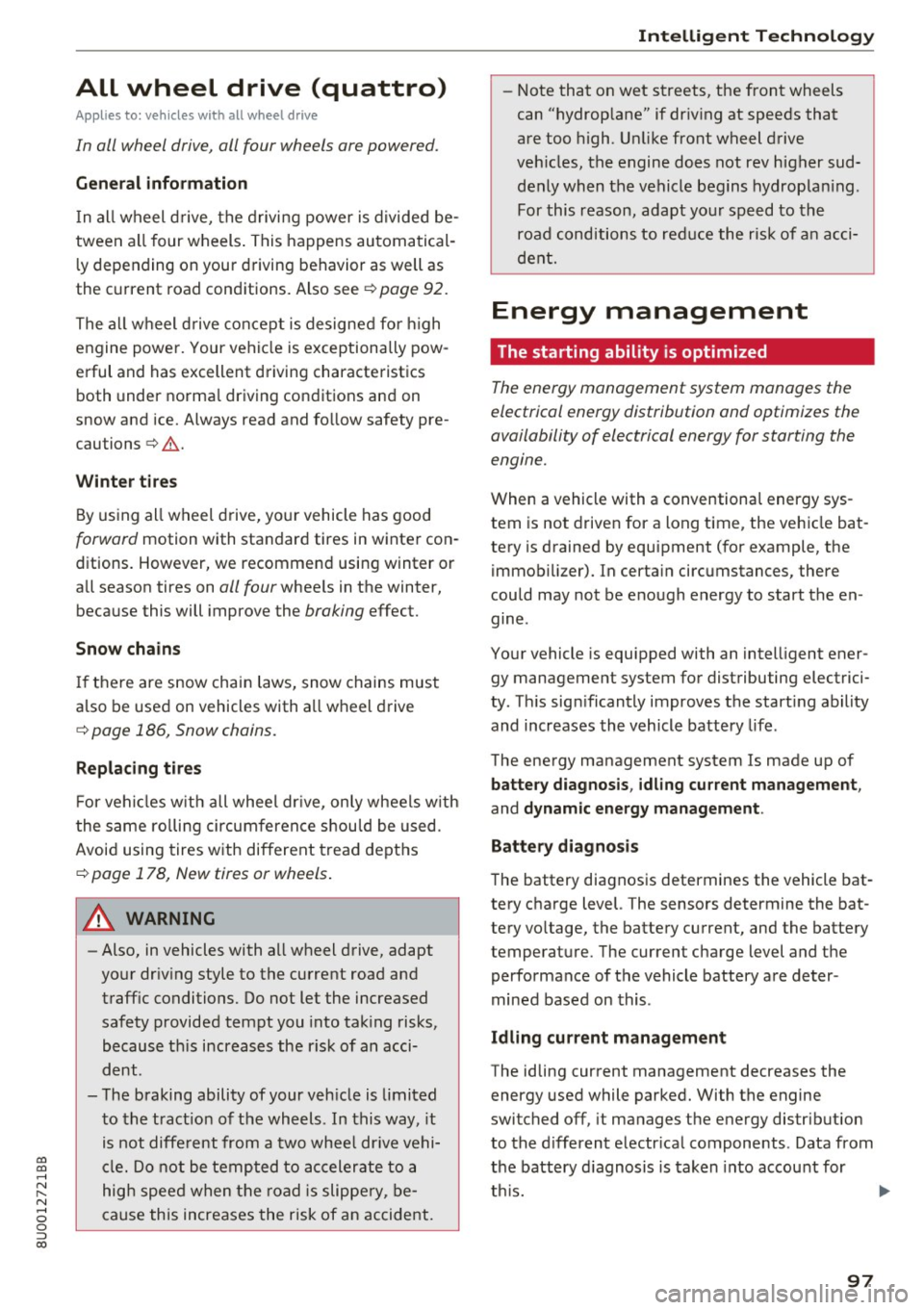
00
00
......
"' ,....
"' ...... 0 0 :::,
00
All wheel drive (quattro)
A ppl ies to: ve hicles wit h all wheel drive
In oil wheel drive, oil four wheels ore powered.
General info rmation
I n all wheel drive, t he driving power is divided be
tween all four wheels . This happens automatical
ly depending on your driving behavior as well as
the current road conditions. Also see
¢ page 92.
The a ll wheel d rive concept is designed for h igh
engine powe r. Your vehicle is exceptionally pow
erful and has excellent driving characteristics both under norma l driving conditions and on
snow and ice. Always read and fo llow safety pre
cautions ¢.&. .
Winter t ires
By using all wheel drive, yo ur vehicle has good
forward motion with standard tires in w inter con
ditions. However, we recommend using winter or
all season tires on
all four whee ls in the winter,
because this will improve the
broking effect.
Snow cha in s
If there are snow chain laws, snow chains must
a lso be used on vehicles with a ll wheel drive
¢ page 186, Snow chains.
Replacing t ires
F or vehicles w ith all wheel dr ive, only wheels w ith
the same ro lling circumference shou ld be used .
Avoid using tires with different tread depths
¢ page 178, New tires or wheels .
A WARNING
-Also, in vehicles with a ll wheel drive, adapt
your dr iv ing style to the current road and
traff ic conditions. Do not let the increased
safety provided tempt you into tak ing risks,
because th is increases the r is k of an acci
dent.
- The braking ability of your veh icle is limited
to the tract ion of the wheels . In this way, it
is not diffe rent from a two whee l dr ive vehi
cl e. Do not be tempted to accelerate to a
high speed when the road is slippe ry, be
cause this increases the risk of an accident .
Intellig ent Technology
- Note that on wet streets, the front wheels
can "hydrop lane" if dr iv ing at speeds that
are too high . Un like front wheel drive
veh icles, the engine does not rev higher sud
denly when the vehicle begins hydroplan ing .
For this reason, adapt yo ur speed to the
road conditions to red uce the risk of an acci
dent.
Energy management
The starting ability is optimized
The energy management system manages the
electrical energy distribution and optimizes the
availability of electrical energy for starting the
engine.
When a vehicle with a conventiona l energy sys
tem is not driven for a long time , the vehicle bat
tery is drained by equipment (for example, the
immobilizer). In certa in circumstances, there
could may not be enough energy to start the en
gine.
Yo ur vehicle is equipped with an intel ligent ener
gy management system for distributing electrici
ty . Th is sign ificantly improves the start ing ability
and increases the vehicle battery life .
The energy management system Is made up of
battery diagnosis , idling current manag em en t,
and dynamic energy manag ement .
Battery diagn osis
The battery diagnosis determines the vehicle bat
tery charge level. The sensors determine the bat
tery voltage, the battery current, and the battery
temperature. The current charge level and the
performance of the vehicle battery a re deter
mined based on this.
Idling current management
The idling current management decreases the energy used while parked. With the engine
switched off, it manages the energy dis tribution
to the d ifferent e lectr ica l components. Data from
the battery d iagnosis is taken into account for
t hi s.
97
Page 162 of 236
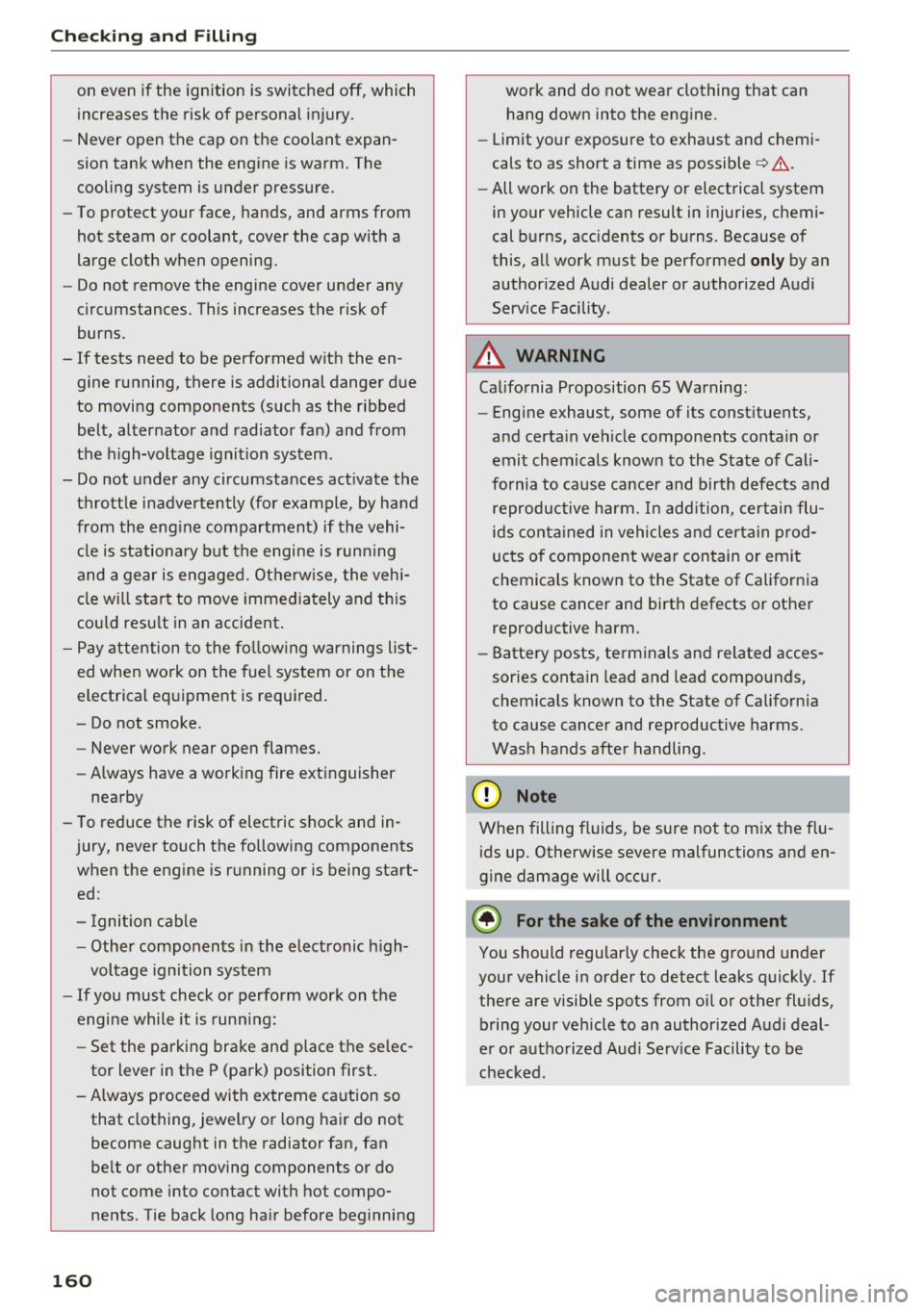
Checking and Filling
on even if the ignition is switched off, which
increases the risk of personal injury.
- Never open the cap on the coolant expan
sion tank when the engine is warm. The
cooling system is under pressure.
- To protect your face, hands, and arms from
hot steam or coolant, cover the cap with a
large cloth when opening.
- Do not remove the engine cover under any
circumstances . This increases the risk of
burns.
- If tests need to be performed with the en gine running, there is additional danger due
to moving components (such as the ribbed
belt, alternator and radiator fan) and from
the high-voltage ignition system .
- Do not under any circumstances activate the throttle inadvertently (for example, by hand
from the engine compartment) if the vehi
cle is stationary but the engine is running
and a gear is engaged. Otherwise, the vehi
cle will start to move immediately and this
could result in an accident.
- Pay attention to the following warnings list
ed when work on the fuel system or on the
electrical equipment is required.
- Do not smoke .
- Never work near open flames.
- Always have a working fire extinguisher
nearby
- To reduce the risk of electric shock and in
jury, never touch the following components when the engine is running or is being start
ed:
- Ignition cable - Other components in the electronic high-
voltage ignition system
- If you must check or perform work on the
engine while it is running:
- Set the parking brake and place the selec
tor lever in the P (park) position first .
- Always proceed with extreme caution so that clothing, jewelry or long hair do not
become caught in the radiator fan, fan
belt or other moving components or do
not come into contact with hot compo
nents . Tie back long hair before beginning
160
work and do not wear clothing that can
hang down into the engine .
- Limit your exposure to exhaust and chemi
cals to as short a time as possible
c:> ,& .
-All work on the battery or electrical system
in your vehicle can result in injuries, chemi
cal burns, accidents or burns. Because of
this, all work must be performed
only by an
authorized Audi dealer or authorized Audi
Service Facility .
A WARNING
California Proposition 6S Warning:
- Engine exhaust , some of its constituents,
and certain vehicle components contain or
emit chemicals known to the State of Cali
fornia to cause cancer and birth defects and
reproductive harm . In addition, certain flu
ids contained in vehicles and certain prod
ucts of component wear contain or emit
chemicals known to the State of California
to cause cancer and birth defects or other reproductive harm .
- Battery posts, terminals and related acces ·
sories contain lead and lead compounds,
chemicals known to the State of California
to cause cancer and reproductive harms. Wash hands after handling.
(D Note
When filling fluids, be sure not to mix the fluids up. Otherwise severe malfunctions and en
gine damage will occur .
@I For the sake of the environment
You should regularly check the ground under
your vehicle in order to detect leaks quickly. If
there are visible spots from oil or other fluids, bring your vehicle to an authorized Audi deal
er or authorized Audi Service Facility to be
checked .